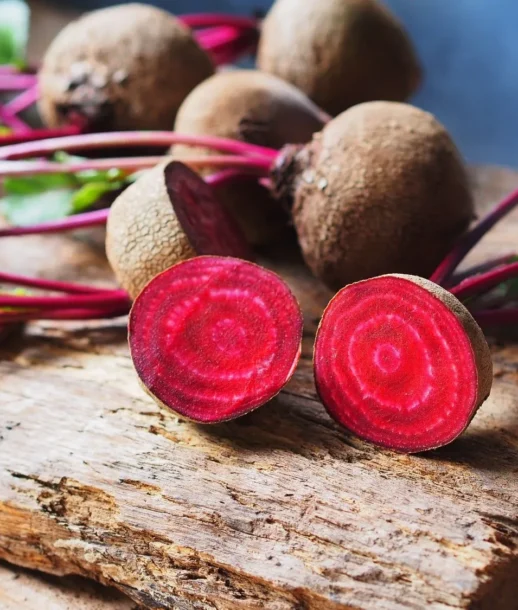Beetroot, also known as red beet, table beet, garden beet, or simply beet, is a root vegetable that is typically deep red. It is a member of the Amaran-thaceae family, which also includes spinach, amaranth, and quinoa. Beets are native to the Mediterranean region and have been cultivated for thousands of years.
Beets are a good source of vitamins and minerals, including fiber, folate (vitamin B9), manganese, potassium, iron, and vitamin C. They are also a good source of nitrates, which are converted into nitric oxide in the body. Nitric oxide is a vasodilator, which means that it helps to widen blood vessels and improve blood Flow.
Beets can be eaten raw, cooked, or juiced. They can be added to salads, soups, stews, and smoothies. Beets can also be used to make hummus, Falafel, and other dishes.
Potential health benefits of beetroot:
- Lower blood pressure
- Improved exercise performance
- Reduced inflammation
- Better digestive health
- Improved cognitive Function
- Reduced risk of cancer
Beets are a nutritious and versatile vegetable that can be enjoyed in many different ways. They are a great addition to a healthy diet.
Beetroot (Beta vulgaris) is a biennial plant, meaning that it takes two years to complete its life cycle. In the first year, the plant grows a Fleshy taproot and leafy greens. In the second year, the plant flowers and produces seeds.
Taproot: The beetroot taproot is the edible part of the plant. It is typically deep red, but can also be white, yellow, or orange. The taproot is round or oval in shape and can grow to be several inches in diameter.
Leaves: Beetroot leaves are large and heart-shaped. They have a dark green color with a reddish-purple underside. The leaves are edible and can be cooked like spinach.
Flowers: Beetroot Flowers are small and green. They are arranged in clusters on a tall stem. The Flowers are pollinated by wind and insects.
Seeds: Beetroot seeds are small and brown. They are produced in clusters of three to five seeds.
Botany: Beetroot is a member of the Amaranthaceae family, which also includes spinach, amaranth, and quinoa. Beets are native to the Mediterranean region and have been cultivated for thousands of years.
Varieties: There are many different varieties of beetroot available. Some popular varieties include:
- Detroit Dark Red: This variety is known for its deep red color and sweet Flavor.
- Golden Beet: This variety has a golden yellow color and a mild flavor.
- Chioggia Beet: This variety has a striped interior with alternating rings of red and white.
- Bull’s Blood Beet: This variety has a dark red color and a strong flavor.
Beetroot is a rich source of various chemical constituents, including:
Beet pigments (betalains): Betalains are a class of water-soluble pigments that give beetroot its characteristic red color. Betalains have antioxidant and anti-inflammatory properties.
Flavonoids: Flavonoids are a group of plant compounds with antioxidant and anti-inflammatory properties. Some of the flavonoids found in beetroot include quercetin, kaempferol, and luteolin.
Polyphenols: Polyphenols are another group of plant compounds with anti-oxidant and anti-inflammatory properties. Some of the polyphenols found in beetroot include gallic acid, caffeic acid, and syringic acid.
Vitamins and minerals: Beetroot is a good source of vitamins and minerals, including Fiber, Folate (vitamin B9), manganese, potassium, iron, and vitamin C.
Nitrates: Beetroot is a good source of nitrates, which are converted into nitric oxide in the body. Nitric oxide is a vasodilator, which means that it helps to widen blood vessels and improve blood flow.
In addition to these major chemical constituents, beetroot also contains a variety of other compounds, including amino acids, saponins, and volatile oils.
The chemical constituents of beetroot are responsible for many of its health benefits. For example, the betalains in beetroot have been shown to lower blood pressure, improve exercise performance, and reduce inflammation. The flavonoids and polyphenols in beetroot have antioxidant and anti-inflammatory properties, which can help to protect against chronic diseases such as cancer and heart disease.

